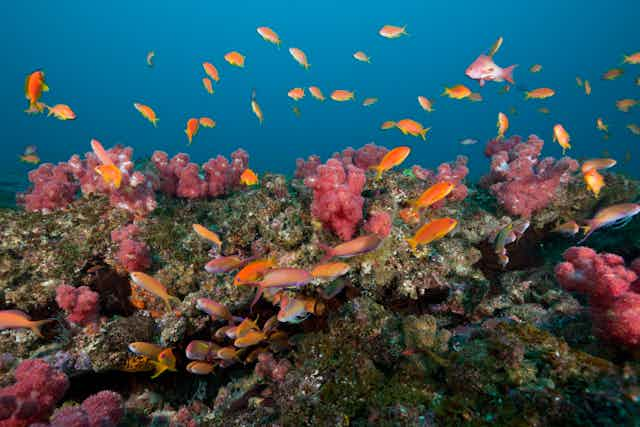South Africa’s government conservation organisations have experienced substantial budget cuts. Even after steps to cut costs, South African National Parks reported a big shortfall (R223 million or about US$11.92 million) for 2021/22. So did the provincial body KZN Ezemvelo Wildlife (R89 million; about US$4.77 million).
South African conservation authorities manage millions of hectares of protected areas. However, recruitment freezes and insufficient funds have reduced their ability to conduct basic operations. One of these is biodiversity monitoring.
Knowing which plants and animals are present in protected areas and where they are is vital for making conservation decisions. You need to know what you have and where it is to monitor and manage it. This kind of information is known as biodiversity occurrence data.
Low data collection
With the current shortage of staff capacity in South African government conservation organisations, this data is not always collected, processed, curated or available.
Through our research and personal experience, we know that many existing species checklists for protected areas are out of date. This is because of species name changes, unrecorded species and changes in species occurrences. When there is capacity to conduct monitoring, it is not always possible to use the data. That’s because there isn’t capacity to digitise, clean, standardise, curate and analyse the data. Data is also lost when staff leave conservation organisations and data isn’t managed or handed over properly.
Our study
With funding from the JRS Biodiversity Foundation, we started a project to improve the management of biodiversity occurrence data at South African National Parks. We reviewed the literature and sources of data and the tools available to manage biodiversity information.
There is a wealth of resources that protected area staff can use. And the public can assist in many ways. In our paper, we provide recommendations for cash-constrained conservation organisations to use these tools to record, collate, standardise, and share information about species locality.
Resources and tools for collating data
The “FAIR” data principles of Findability, Accessibility, Interoperability and Reusability are very important to make data accessible and useful. Biodiversity information standards help make data compatible across different organisations. The Darwin Core standard is commonly used on global data-sharing platforms like the Global Biodiversity Information Facility. This platform includes herbarium and museum specimen records and citizen science records from recording platforms such as iNaturalist. Data from the Global Biodiversity Information Facility is useful for developing and maintaining species checklists.
Maintaining a list of current species is not as simple as it sounds. Names of species change. Scientific discoveries reclassify species in different parts of their range. Taxonomists adjust the alignment of species to related species in other countries. The South African National Biodiversity Institute annually releases an updated South African National Plant Checklist of scientific names. This is a useful source of current accepted plant names for the country.
A national list for animals does not yet exist, so South African scientists use other sources to check animal species names. For example, marine biologists use the World Register of Marine Species as a source of accepted names. The Global Biodiversity Information Facility (GBIF) also provides a way to standardise names in checklists. This way you know whether two different names from different places or times refer to the same plant or animal. GBIF makes this possible by indicating whether each name associated with an observation record is the current accepted name.
Ordinary citizens can contribute to collating biodiversity data through internet-based platforms like eBird for bird observations and iNaturalist for pictures of plants and animals. Volunteers can contribute to data processing by identifying species and annotating behaviours for camera trap photographs on Zooniverse. They can digitise herbarium vouchers on DigiVol. There are also artificial intelligence tools, such as TrapTagger and WildID, which identify species in photographs from camera traps.
Scientists also have their role to play. In the past, some researchers have resisted sharing their data, partly because of capacity constraints. This impedes conservation progress. Recently, there has been more pressure from funders and the open science community for researchers to make their data available. Platforms such as GBIF and Dryad Digital Repository make this easier.
Staff of protected area organisations should also be encouraged to publish protected area checklists on GBIF and iNaturalist. The information is then more readily available to inform management.
By 2022, the total number of observations on iNaturalist had reached more than 33 million and 40% of these needed further identification. Experts, scientists and protected area staff, who can accurately identify species, can assist. Experts can also verify identifications of species that haven’t been recorded before in a protected area.
Read more: Red tape is choking biodiversity research in South Africa. What can be done about it?
Looking forward
Although there are many tools for collating data about the plants and animals occurring in specific places, there is limited awareness in conservation organisations about the wealth of existing historical specimens and the visual and audio data available for download. The capacity to access and use this treasure trove of data needs to be built.
Our paper provides practical guidelines to assist conservation organisations to collate standardised biodiversity occurrence data. This will improve the quality of information used in assessments and ultimately our ability to respond to the highest priority conservation issues.

